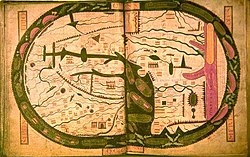T and O map
Type of medieval world map From Wikipedia, the free encyclopedia
A T and O map or O–T or T–O map (orbis terrarum, orb or circle of the lands; with the letter T inside an O), also known as an Isidoran map, is a type of early world map that represents the Afro-Eurasian landmass as a circle divided by the Mediterranean sea, the river Tanais (Don) and the Nile.[1] The origins of this diagram are contested, with some scholars hypothesizing an origin in Roman or late antiquity, while others consider it to have originated in 7th or early-8th century Spain.[2]


The earliest surviving example of a T-O map is found in a late-7th or early-8th century copy of Isidore of Seville's (c. 560–636) De natura rerum, which alongside his Etymologiae (c. 625) are two of the most common texts to be accompanied by such a diagram in the Middle Ages.[3] A later manuscript added the names of Noah's sons (Sem, Iafeth and Cham) for each of the three continents (see Biblical terminology for race).[4] A later variation with more detail is the Beatus map drawn by Beatus of Liébana, an 8th-century Spanish monk, in the prologue to his Commentary on the Apocalypse.
Relevant textual descriptions of the world
The earliest T-O maps are closely associated with two sections of the work of Isidore of Seville:
De Natura Rerum 48.2-3 (drawn verbatim from Hyginus' De astronomia 1.9(8) and Augustine of Hippo's City of God 16.17[5]):
So the earth may be divided into three sides (trifarie), of which one part is Europe, another Asia, and the third is called Africa. Europe is divided from Africa by a sea from the end of the ocean and the Pillars of Hercules. And Asia is divided from Libya with Egypt by the Nile... Moreover, Asia – as the most blessed Augustine said – runs from the southeast to the north ... Thus we see the earth is divided into two to comprise, on the one hand, Europe and Africa, and on the other only Asia.[6]
Etymologiae 14.2.1:
The world is called round after the roundness of a circle, because it is like a wheel [...] Because of this, the Ocean flowing around it is contained in a circular limit, and it is divided in three parts, one part being called Asia, the second Europe, and the third Africa.[7]
History and description
Summarize
Perspective
Spherical Earth concept
Although Isidore taught in the Etymologiae that the Earth was "round", his meaning was ambiguous and some writers think he referred to a disc-shaped Earth. However, other writings by Isidore make it clear that he considered the Earth to be spherical.[8][9] Indeed, the spherical Earth had been the prevailing scholarly assumption since at least Aristotle, who had delineated a frigid clime at the poles, a torrid clime near the equator, and a habitable temperate clime in between.


The T and O map represents only half of the spherical Earth,[10] presumably a convenient projection of the known northern temperate region. It was believed that no one could cross the torrid equatorial clime and reach the unknown lands to the south, the antipodes.[10][11]
Boundaries, center and orientation
The T is the Mediterranean, the Nile, and the Don (formerly called the Tanais) dividing the three continents, Asia, Europe and Africa, and the O is the encircling ocean. Jerusalem was generally represented in the center of the map as the navel of the world, the umbilicus mundi. Asia was typically the size of the other two continents combined.[citation needed]
Because the Sun rose in the east, Paradise (the Garden of Eden) was generally depicted as being in Asia, and Asia was situated at the top portion of the map.[citation needed]
Additional details
This qualitative and conceptual type of medieval cartography could yield extremely detailed maps in addition to simple representations. The earliest maps had only a few cities and the most important bodies of water noted. The four sacred rivers of the Holy Land were always present.[dubious – discuss][citation needed]
Different cartographic material, which represented more useful tools for the traveler, were the itinerarium, which listed in order the names of towns between two points, and the periplus that did the same for harbors and landmarks along a seacoast.[citation needed]
Later maps of the T-and-O conceptual format featured many rivers and cities of Eastern as well as Western Europe, and other features encountered during the Crusades. Decorative illustrations were also added in addition to the new geographic features. The most important cities would be represented by sketches of fortifications and towers in addition to their names, and the empty spaces would be filled with mythical creatures.[citation needed]
Gallery
- The world map from the Saint-Sever Beatus, dating to ca. AD 1050.
- From a 12th c. copy of Etymologiae.
- Map centred on Delos according to Greek tradition, from a French manuscript of Henry of Huntingdon, late 13th century
- Mappa Mundi in La Fleur des Histoires, 1459–1463.
- The Bünting cloverleaf map. A 1581 woodcut, Magdeburg. Jerusalem is in the center, surrounded by Europe, Asia and Africa.
- Unknown, Mer des hystoires world map, 1491, following the model of the T-O map, centered on Jerusalem with East (the biblical location of Paradise) at the top.
- On the left part of the sheet is a zonal or climatic map, communicating geographical information. On the right is a "T-O" map. By Jacobus Philippus Bergomensis.
- T and O map accompanied by a V-in-square map, from a copy of the Etymologiae (c. late 8th century).
- Map from the Saint Gall Isidore manuscript.
- T and O map from the Flemish manuscript of Brunetto Latini, Le Livre dou Tresor, early 14th century.
See also
- Flat Earth, world view
- Globus cruciger
- Mappa mundi, medieval world map
- Babylonian Map of the World
References
Further reading
Wikiwand - on
Seamless Wikipedia browsing. On steroids.










